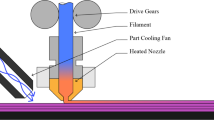Abstract
3D printing has become a promising technique for industry production. This paper presents a research on the manufacturability optimization of discrete products under the influence of 3D printing technology. For this, we first model the problem using a tree structure, and then formulate it as a linear integer programming, where the total production time is to be minimized with the production cost constraint. To solve the problem, a differential evolution (DE) algorithm is developed, which automatically determines whether traditional manufacturing methods or 3D printing technology should be used for each part of the production. The algorithm is further quantitatively evaluated on a synthetic dataset, compared with the exhaustive search and alternating optimization solutions. Simulation results show that the proposed algorithm can well combine the traditional manufacturing methods and 3D printing technology in production, which is helpful to attain optimized product design and process planning concerning manufacture time. Therefore, it is beneficial to provide reference of the widely application and further industrialization of the 3D printing technology.
Similar content being viewed by others
References
Oropallo W, Piegl L A. Ten challenges in 3D printing. Engineering with Computers, 2016, 32(1): 135–148
Barnatt C. 3D Printing: The Next Industrial Revolution. Charleston: Create Space Independent Publishing Platform, 2013
Atzeni E, Salmi A. Economics of additive manufacturing for endusable metal parts. International Journal of Advanced Manufacturing Technology, 2012, 62(9–12): 1147–1156
Dolphin J. 3D printing: piracy or opportunity? Keeping Good Companies, 2012, 64(5): 300–303
Cesaretti G, Dini E, De Kestelier X, Colla V, Pambaguian L. Building components for an outpost on the lunar soil by means of a novel 3D printing technology. Acta Astronautica, 2014, 93(1): 430–450
Yan Y, Qi H. The connotation and application of rapid manufacturing. Aviation Manufacturing Technology, 2004: 26–29
Lu B H, Li D C. Development of additive manufacturing (3D printing) technology. Machine Building & Automation, 2013, 42: 1–4
Wang H M. Materials fundamental issues of laser additive manufacturing for high-performance large metallic components. Acta Aeronautica Et Astronautica Sinica, 2014, 35: 2690–2698
Tuck C, Hague R, Burns N. Rapid manufacturing: impact on supply chain methodologies and practice. International Journal of Services & Operations Management, 2006, 3(1): 1–22
Holmström J, Partanen J, Tuomi J, Walter M. Rapid manufacturing in the spare parts supply chain alternative approaches to capacity deployment. Journal of Manufacturing Technology Management, 2010, 21(6): 687–697
Nyman H J, Sarlin P. From bits to atoms: 3D printing in the context of supply chain strategies. In: Proceedings of the 47th IEEE Hawaii International Conference on System Sciences. 2014, 4190–4199
Rayna T, Striukova L. Adaptivity and rapid prototyping: how 3D printing is changing business model innovation. In: van den Berg B, van der Hof S, Kosta E, eds. 3D Printing, Vol 26. Hague: T.M.C. Asser Press, 2015, 167–182
Liu X L, Deng C, Lang B, Tao D C, Li X L. Query-adaptive reciprocal hash tables for nearest neighbor search. IEEE Transactions on Image Processing, 2015, 25(2): 907–919
Liu X L, Mu Y D, Zhang D C, Lang B, Li X L. Large-zcale unsupervised hashing with shared structure learning. IEEE Transactions on Cybernetics, 2015, 45(9): 1811–1822
Nachtigall K, Voget S. A genetic algorithm approach to periodic railway synchronization. Computers & Operations Research, 1996, 23(5): 453–463
Canellidis V, Giannatsis J, Dedoussis V. Evolutionary computing and genetic algorithms: paradigm applications in 3D printing process optimization. In: Tsihrintzis G A, Virvou M, Jain L C, eds. Intelligent Computing Systems, Vol 627. Berlin: Springer-Verlag, 2016, 271–298
Das S, Suganthan P N. Differential evolution: a survey of the state-of-the-art. IEEE Transactions on Evolutionary Computation, 2011, 15(1): 4–31
Vasile M, Minisci E, Locatelli M. An inflationary differential evolution algorithm for space trajectory optimization. IEEE Transactions on Evolutionary Computation, 2011, 15(2): 267–281
Storn R, Price K. Differential evolution—a simple and efficient heuristic for global optimization over continuous spaces. Journal of Global Optimization, 1997, 11(4): 341–359
Xu H, Li D. Review and outlook process planning research. Manufacturing Automation, 2008, 30: 1–7
Ba L, Li Y, Yang M, Liu Y. Integrated process planning and scheduling problem with consideration of assemble and transportation. Computer Integrated Manufacturing Systems, 2015, 9: 2332–2342
Pan X. Principle and application of concurrent engineering. Beijing: Tsinghua University Press, 1998
Liao W, Guo Y, Cheng X. BOM modeling based on multi-color graph. Journal of Shandong University (Engineering Science), 2008: 70–75
Chao Y, Yang J, Wu Z. Automatic positioning design based on graph theory. Journal of Zhejiang University (Engineering Science), 2005, 39(12): 1925–1929
Liu X L, He J F, Lang B, Chang S F. Hash bit selection: a unified solution for selection problems in hashing. In: Proceedings of the IEEE Conference on Computer Vision and Pattern Recognition (CVPR). 2013, 1570–1577
Shen F, Shen C, Shi Q, Hengel A, Tang Z, Shen H T. Hashing on nonlinear manifolds. IEEE Transactions on Image Processing, 2015, 24(6): 1839–1851
Acknowledgements
This paper was supported by the National Natural Science Foundation of China (Grant No. 71372007). We also would like to extend our sincere gratitude to the reviewers for their instructive advices and useful suggestions on this paper. Special thanks should go to the friends who have put considerable time and effort into their comments on the draft.
Author information
Authors and Affiliations
Corresponding author
Additional information
Yu Han is a PhD candidate of the School of Economics and Management, Beihang University, China. Her research domains focus mainly on operational process management. Her subject of the thesis is the influence of 3D printing on manufacturability of product design.
Guozhu Jia is a professor of the School of Economics and Management, Beihang University, China. His research domains focus mainly on the operational strategy for multi-variety and high-volume production, cellular manufacturing, and operational process management. Now he is interested in studying the influence of 3D printing on supply chain management and manufacturability of product design.
Electronic supplementary material
Rights and permissions
About this article
Cite this article
Han, Y., Jia, G. Optimizing product manufacturability in 3D printing. Front. Comput. Sci. 11, 347–357 (2017). https://doi.org/10.1007/s11704-016-6154-6
Received:
Accepted:
Published:
Issue Date:
DOI: https://doi.org/10.1007/s11704-016-6154-6




